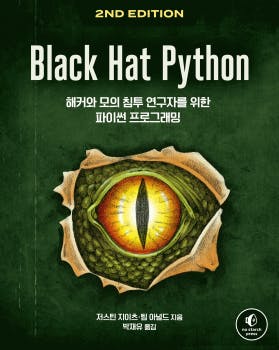Justin Seitz and Tim Arnold, "Black Hat Python, 2nd Edition", NoStarch, 2021
Introduction
In an era where digital information and security have become paramount, delving into the realms of hacking and cyber defense is increasingly vital. The book "Black Hat Python, 2nd Edition", penned by renowned authors Justin Seitz and Tim Arnold, provides an in-depth exploration into this complex yet intriguing world. Published by NoStarch in 2021, this compelling piece is an absolute treasure trove for security analysts and cybersecurity enthusiasts alike, serving as a guide into the darker aspects of Python's capabilities. It allows readers to harness the power of Python, a language universally lauded by security analysts for crafting potent and effective hacking tools.
A comprehensive update from its preceding version, the second edition of "Black Hat Python" brings to its readers a plethora of new and enhanced content, all meticulously updated to Python 3.x. The book encapsulates a wide array of offensive and defensive cybersecurity techniques. It adeptly covers a multitude of subjects, ranging from writing network sniffers and crafting mutation fuzzers, to creating stealthy trojans and investigating virtual machines. The work doesn't merely focus on theoretical knowledge but emphasizes practical learning through illustrative coding examples and detailed explanations of Python libraries such as ctypes, struct, lxml, and BeautifulSoup. Ultimately, "Black Hat Python, 2nd Edition" equips readers with the knowledge and tools to mount robust defenses against cyber threats, and create powerful offensive tools when necessary.
Summary of the Book
Chapter 1: Setting up Your Python Environment
A quintessential guide to kickstarting your journey with Python. It walks you through setting up the Python environment, an integral foundation upon which all subsequent projects will be built. The chapter ensures that readers are well-equipped to begin their exploration of Python’s capabilities in hacking and cybersecurity.Chapter 2: Basic Networking Tools
This chapter focuses on providing an understanding of basic networking tools in Python. The authors explain how to use Python to develop and deploy these tools, laying the groundwork for more complex tasks and projects down the line.Chapter 3: Writing a Sniffer
Diving into the heart of network security, the authors guide you through writing a sniffer in Python. This vital tool allows you to monitor network traffic, essential for both protecting your own systems and understanding potential vulnerabilities in others.Chapter 4: Owning the Network with Scapy
Introduces Scapy, a powerful Python library for network packet manipulation. The chapter focuses on how to leverage Scapy to dominate network activities and detect vulnerabilities.Chapter 5: Web Hackery
Unveiling the intricacies of web hacking using Python, this chapter provides a comprehensive guide to exploiting common web vulnerabilities and securing web applications against potential threats.Chapter 6: Extending Burp Proxy
Teaches how to extend the capabilities of the Burp Suite web-hacking tool using Python. It provides techniques to automate and enhance your web penetration testing workflow.Chapter 7: GitHub Command and Control
This chapter covers how to create a trojan command-and-control server using GitHub, a crucial element in managing distributed malware.Chapter 8: Common Trojaning Tasks on Windows
Delving into the realm of Windows-based attacks, this chapter elucidates common trojan tasks on the Windows platform and demonstrates how to use Python to accomplish them.Chapter 9: Fun with Exfiltration
This chapter revolves around the critical process of data exfiltration - successfully retrieving data undetected. The authors illustrate how to exploit Python's capabilities to achieve this.Chapter 10: Windows Privilege Escalation
Offering a deep dive into the world of Windows systems, this chapter provides a thorough understanding of how to escalate privileges in Windows using Python.Chapter 11: Offensive Forensics
The concluding chapter discusses offensive memory forensics, including retrieving password hashes, discovering vulnerabilities on virtual machines, and leveraging the Volatility Framework for digital investigations. All aimed at demonstrating the depth and breadth of Python's power in the realm of cybersecurity.
My Review Comments
Python is a powerful, high-level programming language widely recognized for its simplicity, versatility, and dynamism. Its easy-to-learn syntax and a large library ecosystem make it an excellent choice for tasks ranging from web development and data analysis to artificial intelligence. With Python, you can prototype ideas swiftly, test and debug code rapidly, and write concise yet readable code, thanks to its high-level abstractions.
Leveraging Python's strengths, security analysts commonly use it to develop robust and potent hacking tools. The second edition of "Black Hat Python" delves into the darker side of Python's capabilities, illustrating how to create network sniffers, steal email credentials, brute force directories, and craft covert trojans. Updated to incorporate Python 3.x, the book also introduces new topics like bit shifting, code hygiene, and offensive forensics using the Volatility Framework. Moreover, it provides expanded information on Python libraries such as ctypes, struct, lxml, and BeautifulSoup and offers advanced hacking tactics.
In fact, I am the translator of the Korean version of this book.

As the Korean translator of this influential book, "Black Hat Python 2/e [해커와 모의 침투 연구자를 위한 파이썬 프로그래밍]", published by 에이콘출판 in 2022, I undertook my task with great responsibility. The book, which enjoys immense popularity in the Amazon Bookstore in the US, serves as a comprehensive guide for simulated penetration testing using Python. It stands out by not only instructing the use of hacking tools but also imparting knowledge on creating these tools, which can contribute to the reader's significant growth.
The translation process was intricate, given the volume of code modifications compared to the first edition. Every example was scrutinized and tested for completeness, and any potential errors were corrected in collaboration with the author, Tim Arnold. I hope this book will guide Korean readers effectively on their journey of learning Python hacking, and it would be an honor if it can serve as a helpful resource.
![[Book Review] Black Hat Python, 2nd Edition](https://cdn.hashnode.com/res/hashnode/image/upload/v1685081315794/260f0d5f-db1e-4604-bac3-0901c517fb8f.png?w=1600&h=840&fit=crop&crop=entropy&auto=compress,format&format=webp)